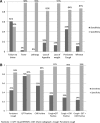The Role of Clinical Symptoms in the Diagnosis of Intrathoracic Tuberculosis in Young Children
- PMID: 26226446
- PMCID: PMC4604651
- DOI: 10.1097/INF.0000000000000847
The Role of Clinical Symptoms in the Diagnosis of Intrathoracic Tuberculosis in Young Children
Abstract
Background: Childhood tuberculosis (TB) is usually Mycobacterium tuberculosis (MTB) culture negative. Furthermore, clinical presentation may be altered by active case finding, isoniazid prophylaxis and early treatment. We aimed to establish the value of presenting symptoms for intrathoracic TB case diagnosis among young children.
Methods: Healthy, HIV-uninfected, South African infants in an efficacy trial of a novel TB vaccine (MVA85A) were followed for 2 years for suspected TB. When suspected, investigation followed a standardized algorithm comprising symptom history, QuantiFERON Gold-in-Tube, chest radiography (CXR), MTB culture and Xpert MTB/RIF from paired gastric lavage and induced sputa. Adjusted odds ratios and 95% confidence intervals describe the associations between symptoms and positive MTB culture or Xpert MTB/RIF, and CXR compatible with intrathoracic TB.
Results: Persistent cough was present in 172/1017 (16.9%) of the children investigated for TB. MTB culture/Xpert MTB/RIF was positive in 38/1017 children (3.7%); and CXR was positive, that is, compatible with intrathoracic TB, in 131/1017 children (12.9%). Children with persistent cough had more than triple the odds of a positive MTB culture/Xpert MTB/RIF (adjusted odds ratios: 3.3, 95% confidence interval: 1.5-7.0) and positive CXR (adjusted odds ratios: 3.5, 95% confidence interval: 2.2-5.5). Persistent cough was the only symptom that differentiated children with severe (56.5%) from nonsevere intrathoracic TB disease (28.2%; P = 0.001).
Conclusion: Persistent cough was the cardinal diagnostic symptom associated with microbiologic and radiologic evidence, and disease severity, of intrathoracic TB. Symptom-based definitions of TB disease for diagnostic, preventive and therapeutic studies should prioritize persistent cough above other symptoms compatible with childhood TB.
Conflict of interest statement
The authors have no conflicts of interest to disclose.
Figures
References
-
- CDC. TB in children (global perspective) 2014. Available at: http://www.cdc.gov/tb/topic/populations/TBinChildren/global.htm. Accessed November 10, 2014.
-
- WHO. Global tuberculosis report 2014. 2014.. Available from: http://www.who.int/tb/publications/factsheet_global.pdf. Accessed November 12, 2014.
-
- Marais BJ, Gie RP, Schaaf HS, et al. The natural history of childhood intra-thoracic tuberculosis: a critical review of literature from the pre-chemotherapy era. Int J Tuberc Lung Dis. 2004;8:392–402. - PubMed
-
- Marais BJ, Gie RP, Schaaf HS, et al. The clinical epidemiology of childhood pulmonary tuberculosis: a critical review of literature from the pre-chemotherapy era. Int J Tuberc Lung Dis. 2004;8:278–285. - PubMed
Publication types
MeSH terms
Grants and funding
LinkOut - more resources
Full Text Sources
Medical


